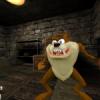Flamethrowers
Alright. Not a complex physics/math problem, but one I''m to tired to figure out on my own.
Basically, I''m making a flamethrower in my game. The problem? the arc. Gravity and flames are not my thing. Think this way.
Im putting the output pressure at around 200 psi, Don''t compensate for things like atmospheric pressure. I just want to know what length the flame should go out to, and about how much of an arc it should have.
Thx
...and that''s how I successfully lead operation Desert Storm.
With love, AnonymousPosterChild
I think that the answer highly depends on the density of your napalm/liquid. But, is it REALLY important how physically accurate that is? Isn''t the visual effect, and playability more important?
I was thinking the same thing; what it looks like is the most important. Length of flame, gravity, psi, forget all that. All that matters is A) it looks cool and B) it''s practial for the (I assume) game 
Peon
The most obvious kind is one that goes in a straight line, expands slowly as it continues forward, and fades quickly to nothing at its end.
The damage it causes should depend on its intensity at that point.
The easiest way to render it is with a bunch of sprites, optionally with animation textures, that travel forward, expand, and fade to nothing.
The damage it causes should depend on its intensity at that point.
The easiest way to render it is with a bunch of sprites, optionally with animation textures, that travel forward, expand, and fade to nothing.
It's not what you're taught, it's what you learn.
Make it a particle engine =) And let all the particles go out with fairly high velocity and give them a negative air resistance type acceleration of -bv^2 where you experiment with the constant b until it looks good. Then you add a little gravitational acceleration, but not too much.
ACtually, I''m going for a good realistic look for it.
The liquid being used has roughly the same density of gasoline, maybe a bit more. Around 0.65 gcm-3
...and that''s how I successfully lead operation Desert Storm.
The liquid being used has roughly the same density of gasoline, maybe a bit more. Around 0.65 gcm-3
...and that''s how I successfully lead operation Desert Storm.
With love, AnonymousPosterChild
bump
Long separated by cruel fate, the star-crossed lovers raced across the grassy field toward each other like two freight trains, one having left York at 6:36 p.m. travelling at 55 mph, the other from Peterborough at 4:19p.m. at a speed of 35 mph.
Long separated by cruel fate, the star-crossed lovers raced across the grassy field toward each other like two freight trains, one having left York at 6:36 p.m. travelling at 55 mph, the other from Peterborough at 4:19p.m. at a speed of 35 mph.
With love, AnonymousPosterChild
If you could calculate the velocity as it leaves the nozzle, you could use that as a vector. You could have a loop that increments in the direction of gravity with some prespecified constant. I don't know how t do the spread, but gravity is the easy part.
Use Waverider's idea for the spead, but add the gravity like I said.
--------------------------------------
I am the master of stories.....
If only I could just write them down...
[edited by - Nathaniel Hammen on December 3, 2002 10:41:44 AM]
Use Waverider's idea for the spead, but add the gravity like I said.
--------------------------------------
I am the master of stories.....
If only I could just write them down...
[edited by - Nathaniel Hammen on December 3, 2002 10:41:44 AM]
I am the master of ideas.....If only I could write them down...
You say you want realistic look to the flame. This involves two things: realistic rendering and realistic movement. Realistic rendering is probably not the thing you''re looking for as we''re on math&physics section.
Realistic movement of flames is a very complex subject. You can check for example the paper entitled "Physically Based Modeling and Animation of Fire" by Nguyen, Fedkiw and Jensen. The methodology presented in the paper clearly is an overshoot for game programming, and it takes several seconds to compute a single frame of realistic flame even on a coarse grid.
The main thing in a realistic (fluid based) movement is that the flame is a global system. If you use particles, the only way to achieve this is to build a model in which the particles affect each other in some way (without these forces, each particle acts only locally). I haven''t read any papers on the subject myself, but I''m aware they do exist. Just read some papers on the subject and you should find some particle-based approaches from the reference lists. Good luck.
- Mikko Kauppila
Realistic movement of flames is a very complex subject. You can check for example the paper entitled "Physically Based Modeling and Animation of Fire" by Nguyen, Fedkiw and Jensen. The methodology presented in the paper clearly is an overshoot for game programming, and it takes several seconds to compute a single frame of realistic flame even on a coarse grid.
The main thing in a realistic (fluid based) movement is that the flame is a global system. If you use particles, the only way to achieve this is to build a model in which the particles affect each other in some way (without these forces, each particle acts only locally). I haven''t read any papers on the subject myself, but I''m aware they do exist. Just read some papers on the subject and you should find some particle-based approaches from the reference lists. Good luck.
- Mikko Kauppila
This topic is closed to new replies.
Advertisement
Popular Topics
Advertisement
Recommended Tutorials
Advertisement







